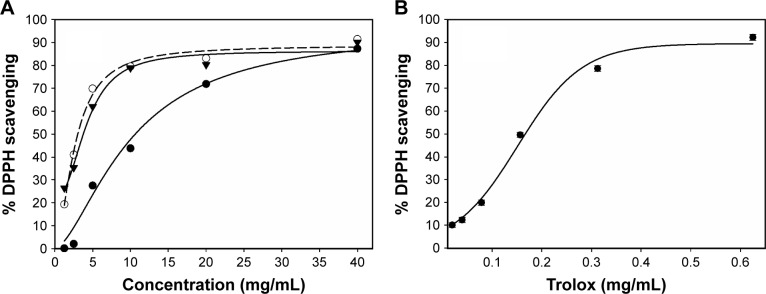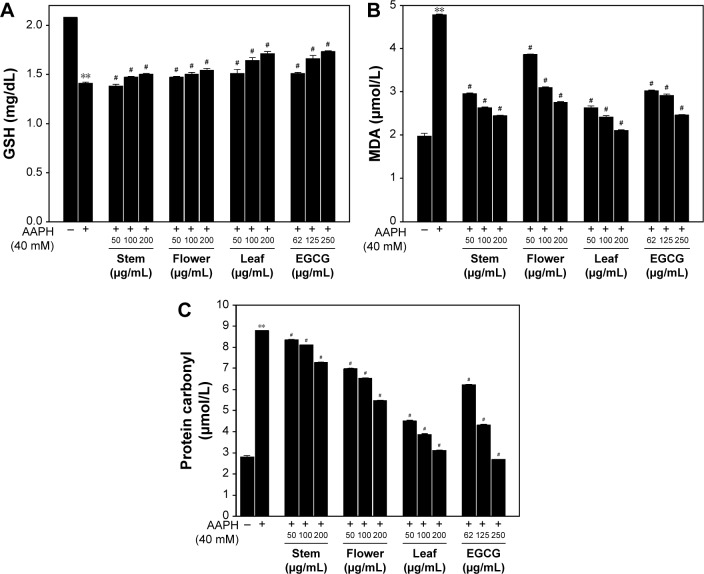Abstract
Vernonia cinerea (VC) Less has been proposed as a medicinal plant with interesting activities, such as an aid for smoking cessation worldwide. Despite its previous clinical success in smoking cessation by exhibiting reduced oxidative stress, it has not been approved. The aim of this study was to investigate various antioxidant activity and active compounds that have not been approved, including the protective activity in human red blood cells (RBCs), from the stem, flower, and leaf extracts of VC Less in vitro. These extracts were tested for their antioxidant activity in scavenging 1,1-diphenyl-2-picrylhydrazyl (DPPH) radicals and analyzed by high-performance liquid chromatography (HPLC) for their active compounds: total tannin, five catechin (C) compounds (epicatechin gallate [ECG], C, epicatechin [EC], epigallocatechin gallate [EGCG], and (−)-epigallocatechin [EGC]), flavonoid, nitrite, nitrate, caffeine, and nicotine. Moreover, antioxidant activities of the extracts were evaluated in 2,2′-azobis(2-amidinopropane) dihydrochloride (AAPH)-treated RBCs. The results showed that the flower and leaf of VC Less had higher activity than the stem in scavenging DPPH radicals. The tannin content in the flower and leaf was higher than that in the stem. The leaf had the highest content of the five catechins (C, EC, EGCG, ECG, and EGC), the same as in the flavonoid, when compared to the stem and flower. Furthermore, the leaf extract had higher nitrate and nitrite than the stem. Nicotine content was found to be higher in the leaf when compared to the flower. In addition, the leaf showed protective activity in glutathione (GSH), malondialdehyde (MDA), and protein carbonyl, with a dose response in AAPH-oxidized RBCs, the same as in standard EGCG. Thus, this study concluded that radical scavenging and antioxidant compounds such as catechins, flavonoid, nitrate and nitrite, and nicotine are present in different VC Less parts and are included in the AAPH-oxidized RBC model.
Keywords: antioxidant activity, anti-smoking aid, bioactive compounds, Vernonia cinerea
Introduction
The World Health Organization (WHO) indicated that the mortality rates from acute or chronic diseases related to smoking will increase to >8 million deaths per year by 2030,1,2 especially among teenagers aged <15 years.3 Nicotine from cigarette smoke contributes to the catecholamine neurotransmitters, as dopamine is a precursor of adrenaline and noradrenaline.4 Previous evidence showed that the low to high nicotine level in human plasma ranged from 95.6 to 236.7 nmol/L5 and can aggravate oxidative stress status and chromosome aberration,6 as well as act as an inflammatory inducer by activating the NF-κB and apoptosis pathways.7 However, these results are still controversial regarding toxicity in the active smoker and they need to be confirmed.
The Thai government is currently promoting various services such as behavioral counseling and/or pharmacotherapy with a one-stop service and 1,600 telephone lines and a smoking cessation clinic at every hospital. Behavioral counseling combined with pharmacotherapy and nicotine replacement therapy (NRT) showed a successful long-term abstinence rate of 30%8–10 and a higher abstinence rate of 50%–70%.11 However, major disadvantages of these services are high cost and many side effects such as nausea, dry mouth, weight gain, and sedation.12 Therefore, the discovery of natural plants to stop smoking in Thailand is challenging and needed.
Today, there are many natural medicinal plants worldwide, including Vernonia cinerea (VC) Less, which is classified in the genus Vernonia (Asteraceae)13 and has approximately 1,000 species.14 It can be found naturally in many Asian regions such as northern Thailand and has specific characteristics of a slender stem, variable leaf shape, and pinkish-purple flowers (Figure 1). Previous pharmacological reports claimed that it can relieve asthma, cough, fever, malaria, urinary calculi, and arthritis,15–17 as well as toxicity in cancer cells.18 VC Less has been reported as a medicinal plant for smoking cessation in Thailand since 198519,20 and was studied at the Thanyarak Institute, Pathum Thani, Thailand, in 2009. The results of a 14-day supplementation program, comprising treatment three times daily and follow-up for 12 weeks, showed a higher continuous abstinence rate (28.1%) when compared to the control group (21.9%).21 However, there was little evidence of active compounds from ethanol extraction such as flavonoids, terpenoids, steroids, saponins, alkaloids, phenols, or tannins, which exhibited antioxidant and anti-inflammatory activities in vitro and in rats.15,22,23 Furthermore, a study in northern Thailand showed a higher rate of smoking cessation in active smokers (59.2% of light cigarette smokers and 54.47% of roll-up cigarette smokers) from the intake of condensed juice from crudely mixed VC Less parts, combined with exercise. In addition, oxidative stress status, such as malondialdehyde (MDA) from lipid peroxidation, protein hydroperoxide, and total antioxidant capacity (TAC), also improved.24 Finally, the VC Less plant has been recorded as a drug that aids smoking cessation in the National List of Essential Medicines (NLEM) in Thailand.25 However, there is a lack of scientific evidence on active compounds in previous VC Less formulas, including the activity of nicotine-induced oxidative stress. Thus, the aim of this study was to identify compounds that are active in the VC Less plant, especially in the stem, flower, and leaf.
Figure 1.
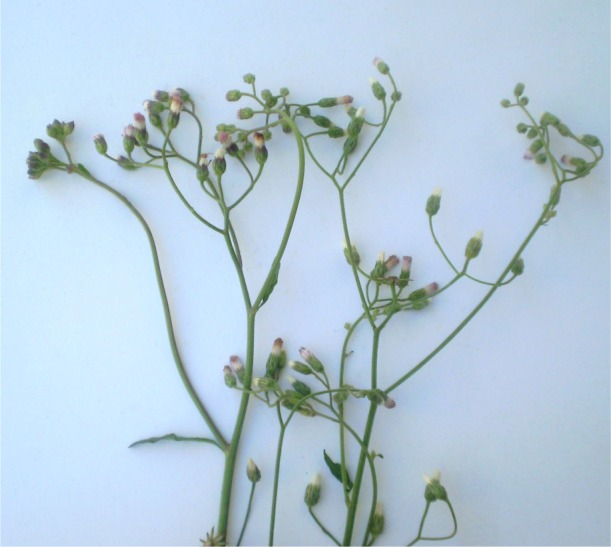
Characteristics of VC Less (×4).
Abbreviation: VC, Vernonia cinerea.
Materials and methods
Standards and equipment
Standard catechins such as (−)-epigallocatechin (EGC), cate-chin (C), epigallocatechin gallate (EGCG), epicatechin (EC), and epicatechin gallate (ECG); Trolox (6-hydroxy-2,5,7,8-tetramethylchroman-2-carboxylic acid); genistein and kaempferol; myricetin; and 2,2′-azobis(2-amidinopropane) dihydrochloride (AAPH) were purchased from Sigma-Aldrich Co. (St Louis, MO, USA). 1,1-Diphenyl-2- picrylhydrazyl (DPPH), 2,4-dinitrophenylhydrazine (DNPH; Acros Organics, Thermo Fisher Scientific, Germany), guanidine hydrochloride (Fluka), and ortho-phosphoric acid (Acros Organics) were obtained from Sigma-Aldrich Co. All the solvents for high-performance liquid chromatography (HPLC) analysis were of analytical reagent and HPLC grades. A spectrophotometer (Libra S22 UV/VIS spectrophotometer; Biochrom, Cambridge, UK) and an HPLC analyzer (Consta Metric 3200 [LDL Analytical]; Fermont, CA, USA) were used in all assays.
VC Less preparation
Naturally grown VC Less materials were collected from a local clean area in Chiang Mai province, Thailand, which was free from toxic insecticide spraying. VC Less characteristics were identified using voucher specimens deposited at the Chiang Mai University Biology herbarium, Department of Biology, Faculty of Science, Chiang Mai University. The VC Less flower, stem, and leaf were separated and washed four times with clean water before being cut into small pieces of approximately one inch in length and dry heated in an oven at 60°C for 2–3 days. All the dry materials were kept in sterile bags containing anti-moisture silica gel pills. VC Less extract from this experiment was prepared by following the procedure of a previous study by Leelarungrayub et al,24 using a water-extraction protocol. A total of 130 mL of condensed VC Less juice was prepared by mixing the dry material (stem, leaf, or flower at 20 g) with clean water (390 mL) and boiling in a traditional pot until the water evaporated. The 130 mL of condensed VC Less juice was filtrated and prepared for extract by the freeze-drying technique.
Antioxidant activity and active compound analysis
DPPH radical scavenging
The antioxidant activity of each VC Less plant extract was analyzed by a DPPH radical scavenging assay.26 Extracted solutions (50 μL) from 1.25–40 mg/mL were mixed with DPPH solutions and kept in the dark for 30 min. Absorbance was read with a spectrophotometer at 515 nm. The percentage of scavenging or inhibition was calculated at 50% (IC50) of each extract from a global curve fit equation in the SigmaPlot program for Windows (version 11.0).
Total tannin
The total tannin content in different VC Less extracts was determined by modifying the previous protocol.27 Each extract was mixed at 20 mg/mL (100 μL) with 0.5 mL of Folin–Denis reagent and Na2CO3 (0.5% w:v) solution and up to 5 mL of distilled water. After mixing for up to 30 min, absorbance was read with a spectrophotometer at 755 nm. The total tannin in each extract was expressed as equivalent to tannic acid (mg) at 1 g of extract.
Catechin
Five catechin compounds, EGC, C, EGCG, EC, and ECG, in each extract were analyzed using HPLC by following the protocol of Bronner and Beecher.28 All the compounds were separated on an RP-C18 column (25 cm × 4 mm i.d. and 5 μm particle diameter; Phenomenex, CA, USA) with a mobile phase of water/acetonitrile/methanol/ethyl acetate/glacial acetic acid (89:6:1:3:1 v/v/v/v/v) at a flow rate of 0.7 mL/min. Catechin compounds were detected by measuring ultraviolet (UV) absorbance at 280 nm, and those in each VC Less extract were calculated by comparing the absorbance of each standard compound from 3.12 to 100 μg/mL.
Flavonoid
Flavonoids such as quercetin, kaempferol, and myricetin were analyzed in each extract using HPLC by following the protocol of Tokusoglu et al.29 Each extract of 5 g was acidified with 10 mL of acidic methanol solution (1% HCl) and refluxed at 70°C for 2 h before measuring by HPLC. Each compound was separated on an RP-C18 column (25 cm × 4 mm i.d. and 5 μm particle diameter; Phenomenex) with a mixed solution of 25:75 (v/v) acetonitrile:pH 2.4 phosphate buffer (25% acetonitrile in 0.025 M NaH2PO4) as a mobile phase at a flow rate of 1.2 mL/min. Quercetin, kaempferol, and myricetin were detected in each extract by measuring UV absorbance at 266 nm and calculated by comparing the absorbance of each standard (100–3 μg/mL).
Nitrite and nitrate
Nitrite and nitrate were analyzed using HPLC by following the protocol of Lulla et al.30 Compounds were separated on an RP-C18 column (25 cm × 4 mm i.d. and 5 μm particle diameter; Phenomenex) with a mixed solution of (0.2%) sodium acetate and (2.5%) glacial acetic acid at a flow rate of 1.0 mL/min at 313 nm. The standard references were sodium and potassium nitrate.
Caffeine
Caffeine was evaluated using HPLC by following the protocol of Harris.31 It was separated on an RP-C18 column (25 cm × 4 mm i.d. and 5 μm particle diameter; Phenomenex) with a mixed solution of 0.5% phosphoric acid and 40% methanol at a flow rate of 1.0 mL/min. Caffeine was identified by measuring UV absorbance at 280 nm, and the concentration was calculated by comparing with standard caffeine.
Nicotine
Nicotine in each extract was evaluated using HPLC by following the protocol of Mangathayaru et al.32 It was identified on an RP-C18 column (25 cm × 4 mm i.d. and 5 μm particle diameter; Phenomenex) with methanol used as a mobile phase at a flow rate of 1.0 mL/min at 260 nm. The nicotine concentration was calculated by comparing with standard nicotine.
Protective activity of AAPH oxidation in human erythrocytes
Human erythrocyte preparation
The protocol was approved by the human ethics committee at the Faculty of Associated Medical Sciences, Chiang Mai University, Thailand (study code: AMSEC-59EM-023). Heparinized blood was collected from a healthy volunteer upon written informed consent before the commencement of the study, and its characteristics were as follows: hemoglobin 14.5 (10–16 g/dL), hematocrits 45 (40%–50%), white blood cell (WBC) count 5,760 (5,000–10,000/cu mm), erythrocyte sedimentation rate (ESR) 87 (80–90 fL), mean corpuscular hemoglobin (MCH) 29.6 (27–32 pg), mean cell hemoglobin concentration (MCHC) 31.8 (27–32 g/dL), hemoglobin type (hemoglobin A2 [HbA2] =2.4%, hemoglobin fetal =0.5%), and glucose-6-phosphatase dehydrogenase [G-6-PD] negative.
AAPH-oxidized red blood cell (RBC)
Whole blood was treated with 1.0 mL of AAPH (40 mM final concentration) solution and co-treated with extract from the stem, flower, or leaf at 50–200 μg/mL or standard EGCG (62–250 μg/mL), before incubating in a water bath at 40°C for 4 h. Negative control blood was incubated with physiological buffer solution (pH 7.2), whereas positive control blood was co-treated with AAPH alone. The total glutathione (GSH) level, MDA, and protein carbonyls were detected in plasma by 5,5′-dithiobis(2-nitrobenzoic acid) (DTNB),33 thiobarbituric acid reactive substances (TBARS) adduct,34 and DNPH35 methods, respectively.
Total GSH determination
AAPH from a mixture of whole blood, with/without extract or standard EGCG, was mixed at 500 μL with 1.6 mL of distilled water and 3.0 mL of precipitating solution. The supernatant (500 μL) was separated by short high-speed centrifugation at 10,000 rpm for 3 min before mixing with DTNB reagent (500 μL). The absorbance was read at 412 nm within 5 min by a spectrophotometer (UV-1200; Shimadzu Co, Kyoto, Japan). The total GSH concentration was compared to the standard curve of standard GSH at 5–20 mg/dL.
TBARS–MDA adduct determination
After being centrifuged at 3,000 rpm for 3 min, 200 μL of plasma was incubated with 750 μL of H3PO4 (440 mmol/L) at room temperature for 10 min. Then, 250 μL of thiobarbituric acid solution (0.6%, w:v) was added. Short-spin centrifugation was performed, and absorbance was read at 532 nm by spectrophotometry. A slightly pink color appeared after heating in a water bath at 90°C for 30 min. The TBARSMDA adduct in plasma was calculated by comparing with the standard curve of standard MDA (bis)acetate (μmol/L).
Protein carbonyl assay
The carbonyl group was evaluated following the original DNPH method. Plasma of 500 μL was mixed with 100 μL of DNPH (10 mmol/L in 0.5 M H3PO4) for 15 min in the dark at room temperature. Then, 250 μL of trichloroacetic acid (50%, w:v) was added in order to precipitate the protein. After the mixture was kept in a cool room (20°C) for at least 15 min, it was high-speed centrifuged for 5 min. The supernatant was removed, and the pellets were washed three times with 1.0 mL of ethanol/ethyl acetate (1:1, v:v), before being dissolved in 1.0 mL of 6 M guanidine HCl. The carbonyl group was calculated at 370 nm after reading absorbance with a spectrophotometer and quantifying the concentration of protein carbonyl groups, with a molar absorption coefficient of 2, as 2,000 M−1⋅cm−1.
Statistical analysis
Assays were performed in triplicate, and the results are shown as mean ± standard deviation. Global linear regression analysis was used to calculate the IC50 values of DPPH radical scavenging by the SigmaPlot program for Windows (version 11.0). The one-way analysis of variance test in SPSS 16.0 for Windows (SPSS Inc., Chicago, IL, USA) was used for statistical analysis between groups, with a significance of P<0.05.
Results
DPPH radical scavenging and antioxidant compounds
Table 1 shows the activity of each extract on scavenging 50% of the DPPH radical. The results showed that the flower extract had the highest activity when compared to the leaf and stem extracts (Figure 2A). This activity was similar to that of standard Trolox scavenging 50% of the DPPH radical (168±0.23 μg; Figure 2B).
Table 1.
All antioxidant activities and active compounds of the stem, flower, and leaf extracts
| Activity/compounds | Stem extract | Flower extract | Leaf extract |
|---|---|---|---|
| DPPH scavenging (IC50) (mg) | 10.8±0.41 | 3.1±0.58 | 3.9±0.48 |
| Total tannin (mg/g extract) | 47.7±0.47 | 66.2±1.37 | 59.3±0.95 |
| Catechins | |||
| ECG (mg/g extract) | 4.56±0.98 | ND | 12.42±1.13 |
| EC (mg/g extract) | 29.12±1.23 | ND | 35.12±1.34 |
| EGCG (mg/g extract) | 0.87±0.04 | 0.89±0.04 | 16.11±0.98 |
| C (mg/g extract) | ND | ND | 165.23±1.22 |
| EGC (mg/g extract) | ND | ND | ND |
| Flavonoid | |||
| Kaempferol (mg/g extract) | ND | 13.76±1.56 | ND |
| Myricetin (mg/g extract) | 47.65±3.29 | 63.33±2.12 | 197.07±4.05 |
| Quercetin (mg/g extract) | ND | 68.89±2.56 | 113.6±5.67 |
| Nitrate and nitrite | |||
| Nitrate (g/g extract) | 0.21±0.11 | ND | 0.19±0.05 |
| Nitrite (g/g extract) | 0.24±0.01 | ND | 0.25±0.05 |
| Caffeine (mg/g extract) | ND | ND | ND |
| Nicotine (mg/g extract) | ND | 1.23±0.11 | 1.54±0.14 |
Note: Data presented as mean ± SD.
Abbreviations: DPPH, 1,1-diphenyl-2-picrylhydrazyl; IC50, inhibitory concentration at 50%; ECG, epicatechin gallate; ND, non-detectable; EC, epicatechin; EGCG, epigallocatechin gallate; C, catechin; EGC, (−)-epigallocatechin; SD, standard deviation.
Figure 2.
DPPH radical scavenging activity of each extract (A) – stem (black circle), leaf (black triangle), and flower (white circle) – and standard Trolox (B).
Abbreviation: DPPH, 1,1-diphenyl-2-picrylhydrazyl.
Antioxidant compounds
The results of active compounds showed the highest content of total tannin in the flower and leaf extracts when compared to the stem extract (Table 1).
The results also showed that leaf extract had the highest content of catechins (C, EC, EGCG and ECG; Figure 3) when compared to the stem and flower extract, of which presented dominated peak of C, ECG, and EC, respectively. Whereas EGC could not be detected in any of the extracts.
Figure 3.
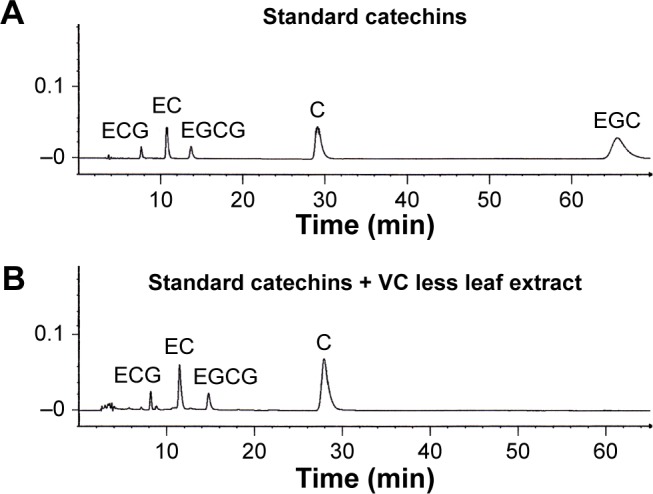
Chromatography peaks for the five pure standard catechins (ECG, EC, EGCG, C, and EGC) (A) and mixed standard catechins and VC Less leaf extract (B).
Abbreviations: ECG, epicatechin gallate; EC, epicatechin; EGCG, epigallocatechin gallate; C, catechin; EGC, (−)-epigallocatechin; VC, Vernonia cinerea.
Flavonoid content was composed of kaempferol, myricetin, and quercetin. The leaf extract showed the highest content of myricetin when compared to the flower and stem extracts. Moreover, the leaf extract showed the highest content of quercetin when compared to the flower extract (Figure 4). However, kaempferol was found in the flower extract, but not in the stem and leaf extracts, similar to undetectable quercetin in the stem extract.
Figure 4.
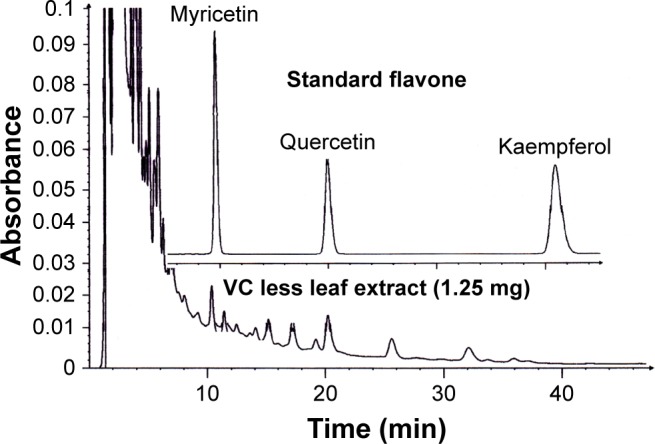
Chromatography peaks for pure standard myricetin, quercetin, and kaempferol and VC Less leaf extract at 1.25 mg/mL.
Abbreviation: VC, Vernonia cinerea.
The results of nitrate and nitrite analyses, both compounds could not be detected in the flower extract, but was found in both leaf and stem extracts, whereas caffeine could not be detected in the stem, flower, or leaf extract of VC Less.
The results also showed that leaf extract had higher nicotine when compared to the flower extract (Figure 5). In addition, nicotine could not be identified in the stem extract in this study.
Figure 5.
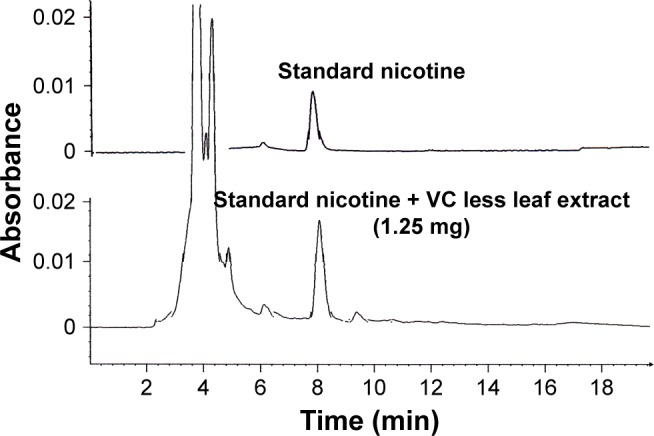
Chromatography peaks for pure standard and mixed standard nicotine and VC Less leaf extract.
Abbreviation: VC, Vernonia cinerea.
Antioxidant activity of VC Less extract in AAPH-oxidized erythrocytes
The preliminary results in this study of AAPH activity in the oxidation of erythrocytes after incubating for 4 h at 40°C are presented in Figure 6. GSH levels reduced with dose after treatment with AAPH at 10, 20 and 40 mmol/L when compared to non-AAPH treatment, whereas MDA and protein carbonyl groups increased responsively to AAPH doses.
Figure 6.

Antioxidant status of GSH, MDA, and the protein carbonyl group levels in blood after treatment with AAPH at 10 ▨, 20 ▩, and 40 ▧ mmol/L when compared to non-AAPH treatment (white bar □).
Note: **P<0.01 when compared to non-AAPH-treated blood (white bar).
Abbreviations: GSH, glutathione; MDA, malondialdehyde; AAPH, 2,2′-azobis (2-amidinopropane) dihydrochloride.
When extracts of the stem, flower, or leaf were co-treated during incubation of AAPH (40 mmol/L) in blood for 4 h, all of them showed protective activity in GSH from AAPH oxidation, with a dose response (50, 100, and 200 μg/mL) the same as that for standard EGCG at 62–250 μg/mL (Figure 7A).
Figure 7.
Activity of VC Less extracts (stem, flower, and leaf) and standard EGCG in GSH (A), MDA (B), and the protein carbonyl group (C) in AAPH-oxidized human blood.
Notes: **P<0.01 when compared to non-AAPH-treated blood and #P<0.01 when compared to AAPH-treated blood.
Abbreviations: VC, Vernonia cinerea; EGCG, epigallocatechin gallate; GSH, glutathione; MDA, malondialdehyde; AAPH, 2,2′-azobis(2-amidinopropane) dihydrochloride.
The results of MDA levels (Figure 7B) showed all the extracts with inhibitory activity in MDA formation from AAPH oxidation, with a dose response (50–200 μg/mL) the same as that for standard EGCG activity (62–250 μg/mL). The leaf extract presented the highest activity in inhibiting MDA formation when compared to the stem, flower, and standard EGCG.
Furthermore, Figure 7C presents the levels of protein carbonyl group from AAPH oxidation. The leaf extract also presented the highest inhibitory activity when compared to the flower and stem extracts with a dose response (50–200 μg/mL) the same as that for standard EGCG at 62–250 μg/mL.
Discussion
The results of this study showed updated evidence of the active compounds and scavenging activity of the stem, flower, and leaf of the VC Less plant in organic DPPH radicals, as well as the protective action in AAPH oxidation of RBCs in an ex vivo model. They possibly support previous results from active smokers in Chiang Mai province,24 especially regarding the reduction of oxidative stress by lowering MDA and enhancing GSH in blood after 14 days of condensed juice use. This study showed that the leaf and flower extracts had higher activity in scavenging DPPH radicals when compared to the stem extract (Table 1 and Figure 2). The antioxidant result on scavenging DPPH radicals in this work was confirmed by a previous study23 that showed dominant active compounds, especially total tannin, catechins, and flavonoids. The extract protocol in this study used water extraction, heating, and freeze-drying techniques as preparative procedures, following a previous study.24 Interesting results showed that catechin (Figure 3) and flavonoid (Figure 4) contents in the leaf extract were higher than that in the stem and flower extracts, whereas the flower extract showed higher total tannin than the leaf extract. Therefore, this result may support the study of Mishra et al.22 Furthermore, the results of nitrate and nitrite analyses showed both catechin and flavonoid compounds in the stem and leaf extracts, but not the flower extract, and caffeine was undetectable in all the extracts. VC Less administration had adverse effects in smokers, such as a dominant sign of tongue numbness, and aversion to the taste or smell of cigarette smoke, with an incidence of 46.9%21 and 100%,24 respectively. Unpublished data intimated that nitrite in VC Less is the direct cause of tongue numbness, but this needs to be confirmed. However, the percentage of smokers presenting side effects differed between studies because of different VC Less preparations. Mixed parts of the VC Less plant packed into a tea bag may have lower nitrite content than that in condensed VC Less juice.
Interesting results from the packed tea bag showed a low nicotine content in the leaf (Figure 5) and flower extracts; therefore, it is possible that this mechanism can stop smoking by nicotine replacement. However, in the study of Wongwiwatthananukit et al,21 crude VC Less was mixed in a tea bag in a clinical setting and this mixing showed adverse events such as upper abdominal pain (21.9%), nausea (28.1%), headache (40.6%), palpitation (15.6%), drowsiness (59.4%), and craving reduction (59.4%), whereas the study of Leelarungrayub et al presented nausea (10.5%) and headache (5.2%) in only the initial week of supplementation with condensed VC Less juice.24 This possibly depends on the nicotine level in VC Less from different preparations, which cannot be assessed. Therefore, concentrated VC Less materials or extract should be clinically used rather than drying and blending in a tea bag.
In addition, the protective activity of VC Less parts in RBCs has presented positive results. AAPH is a free radical initiator and has been used in many studies.36,37 A previous study on AAPH oxidation in human RBCs showed AAPH-induced free radicals that damage human erythrocytes by rapid reduction of GSH after 60 min of incubation and cause almost maximal lipid peroxidation at 180 min, the same as in degraded membrane protein.38 Human RBCs from a healthy volunteer were used as a model in this study for comparing the activity of VC Less extract with standard EGCG. Preliminary results of AAPH oxidation showed that AAPH activity depleted GSH and increased both MDA and protein carbonyl formation was demonstrated with a dose response (10, 20, and 40 mmol/L) after 4 h of incubation (Figure 6). When comparing the antioxidant activity of VC Less extracts, EGCG is the positive control of antioxidant capacity in the system because of its dominantly active compound in the VC Less leaf extract, and it has been suggested as a major catechin with potentially powerful antioxidants when compared to other compounds.39 Co-incubation with EGCG at 62–250 μg/mL in AAPH-RBCs showed antioxidant activity with a dose response, by protecting GSH and inhibiting both MDA and protein carbonyl formation (Figure 7). VC Less leaf extract showed more antioxidant activity by protecting GSH and preventing MDA or protein carbonyl formation with a dose response at 50–200 μg/mL when compared to the stem and flower extracts. This activity can be explained by EGCG and catechin contents, which include flavonoids, especially myricetin and quercetin.40 Therefore, these results possibly support a previous study of active smokers, who reduced oxidative stress after using mixed condensed VC Less juice.24
Previous reports indicated that the activity of the combination of all VC Less parts has an analgesic, antipyretic, and anti-inflammatory effect in rats16,17 and it contains various active compounds such as flavonoids, terpenoids,22 steroids, saponins, alkaloids, phenols, and tannins from methanol extraction.15 However, this natural VC Less plant is still discussed controversially regarding its inflammatory activity. If it contains both antioxidant compound and nicotine in its extract, previous evidence has shown that inflammation can be induced by nicotine.7 Interesting updated results showed that natural products such as parthenolide have anti-inflammatory activity by inhibiting NF-κB.41 Thus, activity of VC Less plant extract also needs more evaluation in the future. However, this study prepared a safety protocol by boiling the plant parts in clean water to condense and then dry them completely to powder by using the freeze-drying technique, thus showing the leaf to have active components, such as special catechins, flavonoids, and nicotine. The results in this study showed that in a partial or complete smoking cessation program combined with psychological counseling or behavior adjustment, with administration with VC Less condense juice from leaves that containing catechines, flavonoid, nitrate, and nicotine, is very encouraging in the future. Furthermore, the VC Less plant can be developed in the future for commercial products that aid in smoking cessation.
Conclusion
The results of this study showed the antioxidant compounds (for example, tannin, catechin, flavonoid, and compounds such as nitrate, nitrite, and nicotine) and activities of VC Less, which included the protective activity of VC Less extracts in AAPH oxidation in human RBCs. VC Less leaf extract, especially, showed more dominant active compounds and activities when compared to the stem and flower extracts. This is a preliminary report that shows active compounds from water-boiled condensation and freeze-drying techniques that can be used for smoking cessation or helping active smokers who want to stop smoking in the future.
Acknowledgments
The authors thank Dr Tanawat Chaowasku of the Department of Biology, Faculty of Science, Chiang Mai University, for helping to identify the characteristics of the VC Less plant. They also thank the Faculty of Associated Medical Sciences, Chiang Mai University, for their grant.
Footnotes
Disclosure
The authors report no conflicts of interest in this work.
References
- 1.Church DE, Pryor WA. Free radical chemistry of cigarette smoke and its toxicological implications. Environ Health Perspect. 1985;64:111–126. doi: 10.1289/ehp.8564111. [DOI] [PMC free article] [PubMed] [Google Scholar]
- 2.World Health Organization . WHO Report on the Global Tobacco Epidemic 2008: the MPOWER Package. Geneva, Switzerland: WHO; 2008. [Google Scholar]
- 3.Ezzati M, Lopez AD. Estimates of global mortality attributable to smoking in 2000. Lancet. 2003;362(9387):847–852. doi: 10.1016/S0140-6736(03)14338-3. [DOI] [PubMed] [Google Scholar]
- 4.Kapoor D, Jones TH. Smoking and hormones in health and endocrine disorders. Eur J Endocrinol. 2005;152(4):491–499. doi: 10.1530/eje.1.01867. [DOI] [PubMed] [Google Scholar]
- 5.Russell MA, Wilson C, Patel UA, Feyerabend C, Cole PV. Plasma nicotine levels after smoking cigarettes with high, medium, and low nicotine yields. Br Med J. 1975;2(5968):414–416. doi: 10.1136/bmj.2.5968.414. [DOI] [PMC free article] [PubMed] [Google Scholar]
- 6.Mundel T, David AJ. Effect of transdermal nicotine administration on exercise endurance in men. Exp Physiol. 2006;91(4):705–713. doi: 10.1113/expphysiol.2006.033373. [DOI] [PubMed] [Google Scholar]
- 7.Crowley-Weber CL, Dvorakova K, Crowley C, et al. Nicotine increases oxidative stress, activates NF-kB and GRP78, induces apoptosis and sensitizes cells to geotoxic/xenobioic stress by a multiple stress inducer, deoxycholate: relevance to colon carcinogenesis. Chem Biol Interact. 2003;145(1):53–66. doi: 10.1016/s0009-2797(02)00162-x. [DOI] [PubMed] [Google Scholar]
- 8.Wongwiwatthananukit S. Role of pharmacists in smoking cessation program. In: Jindavijag B, editor. Ambulatory Pharmaceutical Care. 1st ed. Bangkok: Thai Hospital Pharmacist Association; 2003. pp. 153–174. [Google Scholar]
- 9.Fiore MC, Bailey WC, Cohen SJ. Treating Tobacco Use and Dependence Clinical Practice Guideline. Rockville (MD): US Department of Health and man Services, Public Health Service; 2008. [Google Scholar]
- 10.Stead LF, Perera R, Bullen C, et al. Nicotine replacement therapy for smoking cessation. Cochrane Database Syst Rev. 2012;11:CD000146. doi: 10.1002/14651858.CD000146.pub4. [DOI] [PubMed] [Google Scholar]
- 11.Prochazka AV. New developments in smoking cessation. Chest. 2000;117(4 suppl 1):169–175. doi: 10.1378/chest.117.4_suppl_1.169s. [DOI] [PubMed] [Google Scholar]
- 12.Chea A, Hout S, Long C, et al. Antimalarial activity of sesquiterpene lactones from Vernonia cinerea. Chem Pharm Bull. 2006;54(10):1437–1439. doi: 10.1248/cpb.54.1437. [DOI] [PubMed] [Google Scholar]
- 13.Toyang NJ, Verpoorte R. A review of the medicinal potentials of plants of the genus Vernonia (Asteraceae) J Ethnopharmacol. 2013;146(3):681–723. doi: 10.1016/j.jep.2013.01.040. [DOI] [PubMed] [Google Scholar]
- 14.Keely SC, Jone SB. Distribution of pollen types in Vernonia (Vernonieae: Compositae) Syst Bot. 1979;4:195–202. [Google Scholar]
- 15.Latha RM, Geetha T, Varalakshmi P. Effect of Vernonia cinerea Less flower extract in adjuvant-induced arthritis. Gen Pharmacol. 1998;31(4):601–606. doi: 10.1016/s0306-3623(98)00049-4. [DOI] [PubMed] [Google Scholar]
- 16.Iwalewa EO, Iwalewa OJ, Adeboye JO. Analgesic, antipyretic, anti-inflammatory effects of methanol, chloroform and ether extracts of Vernonia cinerea Less leaf. J Ethnopharmacol. 2003;86(2–3):229–234. doi: 10.1016/s0378-8741(03)00081-3. [DOI] [PubMed] [Google Scholar]
- 17.Mazumder UK, Gupta M, Manikandan L, Bhattacharya PK, Haldar PK, Roy S. Evaluation of anti-inflammatory activity of Vernonia cinerea Less. Extracts in rats. Phytomedicine. 2003;10(2–3):185–188. doi: 10.1078/094471103321659915. [DOI] [PubMed] [Google Scholar]
- 18.Pratheeshkumar P, Kutttan G. Antimetastatic potential of vernolide-A, a sesquiterpenoid from Vernonia cinerea L. Hum Exp Toxicol. 2012;31(1):66–80. doi: 10.1177/0960327111414279. [DOI] [PubMed] [Google Scholar]
- 19.Lhieochaiphant SA. Phytochemical Study of Vernonia cinerea Less [master’s thesis] Chiang Mai: Graduate School, Chiang Mai University; 1985. [Google Scholar]
- 20.Bunyapraphatsara N. Medicinal Plants Indigenous to Thailand. Vol. 5. Bangkok: Department of Pharmacognosy, Faculty of Pharmacy, Mahidol University; 2005. pp. 72–74. [Google Scholar]
- 21.Wongwiwatthananukit S, Benjanakaskul P, Songsak T, Suwanamajo S, Verachai V. Efficacy of Vernonia cinerea for smoking cessation. J Health Res. 2009;23:31–36. [Google Scholar]
- 22.Mishra TN, Singh RS, Upadhyay J, Srivastava R. Chemical constituents of Vernonia cinerea. Part I. Isolation and spectral studies of triterpenes. J Nat Prod. 1984;47:368–372. [Google Scholar]
- 23.Leelaprakash G, Mohan DS, Sivajothi V. Antioxidant and hepatoprotective activities of Vernonia cinerea extract against CCl4 induced hepatotoxicity in albino rats. Int J Pharm Sci Rev Res. 2010;10:30–34. [Google Scholar]
- 24.Leelarungrayub D, Pratanaphon S, Pothongsunun P, Sriboonreung T, Yankai A, Bloomer RJ. Vernonia cinerea Less. Supplementation and strenuous exercise reduce smoking rate: relation to oxidative stress status and beta-endorphin release in active smokers. J Int Soc Sports Nutr. 2010;7:21. doi: 10.1186/1550-2783-7-21. [DOI] [PMC free article] [PubMed] [Google Scholar]
- 25.National List of Essential Medicines (NLEM) [Accessed September30, 2013]. Available from: http://drug.fda.moph.go.th:81/nlem.in.th/sites/default/files/attachments/herbal_book_56.pdf.
- 26.Thitilertdecha N, Teerawutgulraq A, Kilburn JD, Rakariyatham N. Identification of major phenolic compounds from Nephelium lappaceum L. and their antioxidant activities. Molecules. 2010;15(3):1453–1465. doi: 10.3390/molecules15031453. [DOI] [PMC free article] [PubMed] [Google Scholar]
- 27.Polshettiwar SA, Ganjiwale RO, Wadher SJ, Yeole PG. Spectrophoto-metric estimation of total tannins in some Ayurvedic eye drops. Indian J Pharm Sci. 2007;69:574–576. [Google Scholar]
- 28.Bronner WE, Beecher GR. Method for determining the content of catechins in tea infusions by high-performance liquid chromatography. J Chromatogr A. 1998;805(1–2):137–142. doi: 10.1016/s0021-9673(98)00040-5. [DOI] [PubMed] [Google Scholar]
- 29.Tokusoglu O, Unal MK, Yildirim Z. HPLC-UV and GC-MS characterization of the flavonol aglycons quercetin, kaempferol, and myricetin in tomato pastes and other tomato based products. Acta Chromatographica. 2003;13:196–207. [Google Scholar]
- 30.Lulla H, Chen SS, Sena FJ. Simultaneous determination of nitrate and nitrite in toothpastes by high-performance liquid chromatography. J Pharm Sci. 1984;73(7):1004–1006. doi: 10.1002/jps.2600730740. [DOI] [PubMed] [Google Scholar]
- 31.Harris DC. Quantitative Chemical Analysis. 5th ed. New York: WH Freeman and Company; 1999. High performance liquid chromatography: analysis of caffeine and benzoic acid. Experiment 5; pp. 17–20. [Google Scholar]
- 32.Mangathayaru K, Thirumurugan D, Patel PS, Pratap DVV, David DJ, Karthikeyan J. Isolation and identification of nicotine from Leucas aspera (Willd) link. Indian J Pharm Sci. 2006;68:88–90. [Google Scholar]
- 33.Beutler E, Duron O, Kelly BM. Improved method for the determination of blood glutathione. J Lab Clin Med. 1963;61:882–890. [PubMed] [Google Scholar]
- 34.Chirico S. High-performance liquid chromatograph-based thiobarbituric acid tests. Meth Enzymol. 1994;233:314–318. doi: 10.1016/s0076-6879(94)33035-2. [DOI] [PubMed] [Google Scholar]
- 35.Levine RL. Carbonyl modified proteins in cellular regulation, aging and disease. Free Radic Biol Med. 2002;32(9):790–796. doi: 10.1016/s0891-5849(02)00765-7. [DOI] [PubMed] [Google Scholar]
- 36.Betigeri S, Thakur A, Raghvan K. Use of 2,2′-Azobis(2-Amidinopropane) dihydrochloride as a reagent tool for evaluation of oxidative stability of drugs. Pharm Res. 2005;22(2):310. doi: 10.1007/s11095-004-1199-x. [DOI] [PubMed] [Google Scholar]
- 37.He RR, Li Y, Li XD, et al. A new oxidative stress model, 2,2-azobis (2-amidinopropane) dihydrochloride induces cardiovascular damages in chicken embryo. PLoS One. 2013;8(3):e57732. doi: 10.1371/journal.pone.0057732. [DOI] [PMC free article] [PubMed] [Google Scholar]
- 38.Zou CG, Agar NS, Jones GL. Oxidation insult to human red cells induced by free radical initiator AAPH and its inhibition by a commercial antioxidant mixture. Life Sci. 2001;69(1):75–86. doi: 10.1016/s0024-3205(01)01112-2. [DOI] [PubMed] [Google Scholar]
- 39.Singh BN, Shankar S, Srivastava RK. Green tea catechin, epigallocatechin-3-gallate (EGCG): mechanisms, perspectives and clinical applications. Biochem Pharmacol. 2011;82(12):1807–1821. doi: 10.1016/j.bcp.2011.07.093. [DOI] [PMC free article] [PubMed] [Google Scholar]
- 40.Azevedo MI, Pereira AF, Noqueira RB, et al. The antioxidant effects of the flavonoids rutin and quercetin inhibit oxaliplatin-induced chronic painful peripheral neuropathy. Mol Pain. 2013;9:53. doi: 10.1186/1744-8069-9-53. [DOI] [PMC free article] [PubMed] [Google Scholar]
- 41.Penthala NR, Bommagani S, Janganati V, et al. Heck products of parthenolide and melampomagnolide-B as anticancer modulators that modify cell cycle progression. Eur J Med Chem. 2014;85:517–525. doi: 10.1016/j.ejmech.2014.08.022. [DOI] [PMC free article] [PubMed] [Google Scholar]



